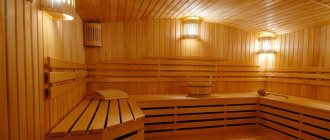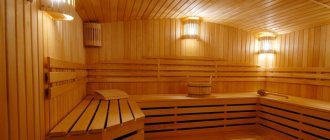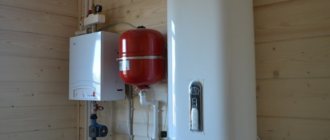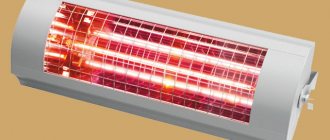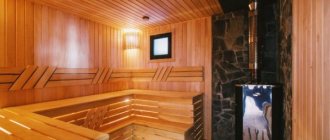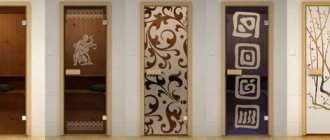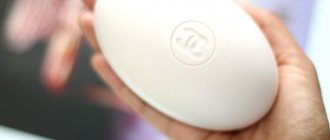A wooden lampshade for a bathhouse can serve not only as a wall item necessary to provide room lighting, but as a decor, providing aesthetic value for vacationers. Thanks to the bath lamp, the socket and the lighting lamp are protected from moisture and mechanical stress. What are the advantages, types and how to make a lamp with your own hands you will learn from this article from Heart of ECO .
Requirements for lighting in baths and saunas
Safety. The first and perhaps the most important criterion. Choose impact-resistant, moisture-proof, heat-resistant lighting fixtures. Make the wiring as protected from moisture and heat as possible.
Durability. In order not to change lamps every six months, you should take care in advance: choose a high-quality, reliable device that will work for a long time in difficult bath conditions.
Aesthetics. An elegant lamp that is pleasing to the eye will promote good rest and relaxation. It is important to choose the color temperature: warm tones help you relax, while cold tones, on the contrary, invigorate. Therefore, for a bath it is better to choose lamps with a low color temperature: 2700-3500 K.
Simplicity and ease of use. Bathroom lighting fixtures are chosen to be as easy to maintain and operate as possible. The simpler the shape of the lamp, the more difficult it is to touch it with your hand or head.
Advantages
Due to the fact that the product is used in unusual conditions, the following requirements apply to its manufacture and use:
- Reliability. The lamp is made of durable material so that when used in conditions of high temperatures and high humidity it does not burst, thereby injuring people.
- Environmental Safety. As a result of the influence of high temperatures, the product may release harmful fumes into the environment from heating the plastic. In this regard, the lampshade must be made of wood or substances that do not contain harmful artificial materials.
- Fire resistance. If wooden products are used as a lamp, it is coated with a special substance to prevent fire. It is also permissible to use non-flammable substances as raw materials for the manufacture of lampshades.
- Moisture resistance and durability. It is prohibited to use fabric or paper as a manufacturing material.
Important! Wood products typically use LED fluorescent lamps for lighting. They do not create fire hazards.
If we talk about the advantages of a wooden product, we can name the following:
- complete environmental friendliness - wood material does not emit harmful substances during its use, but has a beneficial effect on a person’s condition, on his mental and emotional mood;
- wood material is very malleable, which is why it is possible to make lamps of any shape and complexity;
- using lampshades, you give the room a cozy, homely look;
- since there are many types of wood, each of them is used to realize various fantasies of their owner;
- wood can be perfectly combined with other materials.
Proper and safe lighting placement
In addition to the reliability requirements of the light sources themselves, it is important to place them safely.
- You should not place lamps near the stove: hot air will quickly destroy them.
- It is recommended to install wall lamps at an average level: those mounted too close to the ceiling or floor will collect more moisture and condensation.
- Ceiling lamps should not touch people's heads. Therefore, it is recommended to hang ceiling lamps in the corners of the bathhouse.
- The angular location is also good because the lamps shine from behind people’s backs: the light source does not blind the eyes.
- You should not place light sources where you can hit them.
Material and tools for making a lampshade for the steam room
It is better to have a special electric tool. This is a hand router and jigsaw. If they are not there, then you will have to make a wooden lampshade using simple hand tools. True, the quality of the product may suffer and the manufacturing process itself will be significantly lengthened. However, the design of the lampshade (or grille) is not so complex that our diffusing screen would turn out to be too unsightly.
Any wood that does not emit resin will do. Linden, birch, alder, black alder, maple, aspen - this is the material that is widely used when interior finishing of a bathhouse or sauna is made. Therefore, as mentioned above, there should not be a shortage of necessary wood waste.
If the bathhouse has already been built, but there is no necessary waste, you will have to buy it in the store.
- For round lintels, you can take wooden dowels ø 12 mm and 1 meter long.
- For rectangular jumpers - appropriate slats.
- A planed board or furniture board 20 mm thick is suitable for making lower and upper holders.
To fasten the entire structure, you will need thin nails (preferably brass finishing nails for connecting wooden parts).
Tool
- Manual electric router with a set of cutters;
- Electric jigsaw;
- Electric drill (or screwdriver) with a set of drill bits for wood;
- Manual circular;
- Wood hacksaw;
- Hammer;
- Ruler;
- Protractor or square with an angular scale;
- Abrasive sandpaper.
Choosing lamps and fixtures for the relaxation room, shower, steam room
When choosing a lamp, it is important to consider its degree of protection - IP.
IP decryption
All electrical devices indicate the degree of protection. The first number indicates how protected the lamp is from dust and solid particles; the second shows the degree of moisture protection. The bathhouse has several rooms, each of which has its own safety requirements.
Washing area. It consists of several zones:
- Shower room (pool, bath). This is the place of greatest danger for lamps: splashes and jets of water can enter directly. Light sources with a moisture protection level of at least 7 are suitable. For example, ip67/68. They must also be sealed, with anti-corrosion protection.
Lamps (ip68) for showers:
Cariitti LED S-Paver Led 3200 | Cariitti fiber optic S-Paver 3300 |
Cariitti LED S-Paver Led 3200
Cariitti fiber optic S-Paver 3300
- Areas near the shower, pool, faucet. Splashes can also reach lighting fixtures. We recommend a water protection class of at least 5, and a dust protection class of at least 4. Lamps with IP45/46/55 are suitable.
- Zones at a distance of half a meter from the water. Protection from accidental drops will be provided by a lamp with a degree of protection of at least 4: ip44/45.
- Areas where splashes cannot reach. If there are any, then the first protection class is sufficient: ip11/12. It is not recommended to take it lower, as condensation will accumulate in the rooms.
It is better to install dim light bulbs in washing areas. This reduces the likelihood of damage due to accidental ingress of water: the lower the power of the light source, the less the lamp heats up.
Dressing room and rest room. These rooms are protected from direct drops and splashes of water, but condensation is present. Therefore, the degree of moisture protection (second digit in IP) of lamps is at least 1.
The power of the lamps does not play a role in safety; you can set the light to the desired brightness. Experts recommend using less powerful, dim light sources in relaxation rooms for greater relaxation. And in the dressing room you can turn it brighter: 75-100 W for an incandescent lamp or 10-15 W for LED lamps.
Steam zone. Difficult for electricians due to high temperature and humidity. For a steam room, it is important to choose lamps with a heat resistance level of at least 160⁰C. It’s better to choose with a reserve (especially for ceiling light sources): up to 300⁰С. Light sources are chosen with a moisture protection level of at least 5. For example, ip55/65.
Select lamps with heat-resistant, sealed housings, rubber seals, and ceramic (porcelain) sockets. Prefer a protective grille made of stainless steel or with a good galvanic coating.
Lamp options (ip65) for the steam room:
NBB-03-60-003 (Terma 3) | NPP-03-60-021 Bannik 1401 | NPP-03-60-014 Bannik 1302 |
NBB-03-60-003 (Terma 3)
NPP-03-60-021 Bannik 1401
NPP-03-60-014 Bannik 1302
It is recommended to additionally place the lamp in a so-called enclosure. They will look stylish and protect from splinters if the lamp bursts.
Protective wooden lampshade.
Protective wooden lampshade.
The power of the steam room lamps should not exceed 60 W, otherwise the lamp will get very hot on the inside.
A good option would be to organize low-voltage (12 V) lighting. To do this, you will need a step-down transformer and special lamps.
How to attach and install
First of all, it is necessary to prepare the frame and the necessary elements attaching to it. The frame of the housing must be of such a volume that the lighting device can fit inside it. Then the back wall is prepared. It is necessary to calculate the distance between the frame and the wall. The frame should be wrapped in foil. This is necessary to provide additional reflection to enhance the rays. You can also use reflective tape instead of foil. At the last stage of preparation, it is necessary to fasten it with hardware, but this should be hidden from the eyes of the bathhouse visitor to give a more aesthetic appearance.
Types of lamps used
Incandescent lamps
A good option for a steam room or washing room, provided several conditions are met: heat-resistant housing, moisture protection level of at least 5 (ip45/55/65), power does not exceed 60 W. Such a light bulb is inexpensive, and considering that the light in the bathhouse is not on every day, it will last quite a long time.
However, they are quite fragile, so the lamp for incandescent lamps must comply with all safety regulations: sealed and with protective grilles.
There are models with a safe voltage of 36 V with connection via a step-down transformer.
Fluorescent lamps
Despite their advantages - long service life, energy saving - they are not suitable for baths. Fluorescent light sources cannot : they do not work well at temperatures above 60⁰C. This is also a bad option for unheated bathhouses and for the waiting room: frosty air from the street will significantly shorten the service life. In addition, in winter, after freezing, they will take a long time to warm up and start up. In addition, due to the presence of mercury vapor in the composition, they are dangerous if the flask is damaged.
Halogen lamps
Suitable for steam rooms: not afraid of high temperatures, protected from splashes (lamp with internal bulb). Since the light in the bathhouse does not burn constantly, the short service life does not play a significant role. Moreover, halogen lights cost little.
Special halogen lamps are produced especially for baths: they are protected by special heat-resistant housings and have low power (15-35 W).
LED bulbs
Opinions differ about the use of these lamps in the steam room. LED light sources can be used in a sauna, but these lamps begin to physically degrade LEDs at a temperature of 65⁰C (on average). The intensity of the degradation process varies depending on the model.
LED lamps are perfect for any other sauna room. They are not afraid of moisture, heat up slightly during operation, last a long time, and are not afraid of low temperatures. Moreover, it is with their help that you can organize a low-voltage lighting system without any problems. Design possibilities are expanded by the use of LED strips.
Fiber optic lighting for sauna
Expensive, but the most durable, safe option for steam rooms and washrooms. Withstands temperatures up to 220 ⁰С. In addition, due to the physical characteristics of light - lighting works thanks to light waves, and not electric ones - optical fiber is not afraid of water.
With the help of optical fiber, you can come up with many interesting interior solutions.
Example of fiber optic backlight
The essence of such lighting is that the light source (any, but more often LED) is placed not in the room itself, but outside it. Light rays from the lamp “enter” the room through special fiber optic light guides. These are usually glass flexible tubes.
Operating principle of fiber optic lighting
Threaded bits
For the convenience of clients, companies that specialize in lighting baths offer kits for fiber optic lighting. Their cost starts from 25,000 rubles, depending on the configuration.
Salt lamps.
They will not only help illuminate the bathhouse, but will make the atmosphere in it healthier. Salt lamps destroy allergens, microorganisms, and saturate the air with healing vapors.
Salt lamps are made from Himalayan salt. A lampshade is made from salt into which a regular light bulb is screwed. Lampshades are made in different shapes, sizes, and colors. A variety of designs will allow you to decorate any bathhouse.
Caring for the lamp is easy: the main thing is to keep it clean. Keep in mind that in a steam room atmosphere, the lifespan of a salt lamp is reduced because the salt becomes soggy and crumbles in the humid atmosphere of the steam room. The price of such lamps varies greatly depending on the processing of the material. The average price for an untreated lamp weighing 2-3 kg is 700-900 rubles. More about salt lamps
Fiber optic
Fiber optic lighting is perhaps the best option for steam saunas, baths and hammams. This is due to its high resistance to moisture and high temperature, as well as a high level of safety!
Here are some advantages:
- Fiber optic bundles can withstand maximum temperatures up to 200 degrees,
- High light conductivity - produces a good luminous flux with a small fiber cross-section;
- The possibility of short circuit is excluded;
- Functionality - the ability to create various lighting effects;
- Long service life, which for some models reaches 20 years;
- Installation can be carried out in a ready-made room.
Fiber optic models require a projector - a source of light distributed by fiber optics. It is installed outside steam rooms, increasing the level of security.
As a result, we can say that the fiber optic type of lighting makes it possible to achieve absolute safety without losing the quality of the light itself.
Why LED lamps are not the best choice
It was noted above that LED lamps are not the best choice for a steam room. This is due to the design of the lamps.
Firstly, LED consists of semiconductor crystals that emits light. Their physical properties are such that they cannot work at high temperatures (above 100⁰C). But already at 60⁰С, the degradation of semiconductors begins. Therefore, the LED lamp will work, but not for long.
Secondly, LEDs heat up during operation. Heat is removed from them convectively using a radiator. But the temperature in the steam room is extremely high - the heat cannot escape from the lamp. This is the second reason for the rapid deterioration
Considering its considerable cost, there is no point in installing them in a steam room. It is better to make do with other options for bath lamps.
In other rooms, LED lighting is acceptable.
Kinds
Wooden lampshades exist in several types and for different purposes.
Angular
This lampshade has a corner look. It is used to install the product in the corner of a small room. It distributes the light in such a way that there is a warm and soft glow. The wooden lampshade has an original appearance that will perfectly complement the interior of the bathhouse or sauna where it is used. It takes up little space and reliably protects against accidental touching.
Wall
Due to its shape, this type of lampshade can be installed on a straight wall in a steam room. According to its placement, it diffuses light throughout the entire room, creating a comfortable environment in the room. As a rule, it is located behind the person’s field of vision, above the upper ceiling. The lampshade emits a graceful, eye-straining color as it diffuses smoothly across the center of the room.
Lattice
A lattice-shaped wood product appears as a flat or curved sheet with scattering holes through which light passes through. Such lampshades are in perfect harmony with objects placed in baths and saunas. Grilles exist in the form of straight, cylindrical parts or in the form of rods connected to each other. Place the lampshade in the opposite direction, facing the convex plate, to avoid striped shadows from the grille.
Important! How bright the lighting will be in the room depends on the width and number of slots.
Screen
Screen type lampshades consist of a single matte sheet. The front part is made of thin plywood and decorated with shaped holes that allow light from the lamp to pass through. The other side of the screen is covered with mesh.
Advice! You can replace the matte plate with a plate with holes.
Installation features
Electrical wiring plays a vital role in lighting in a bathhouse. A bathhouse is a high-risk room. It is not permissible to neglect electrical safety rules - this can lead to a fire and electric shock.
To prevent electric shock, it is sufficient to install a low-voltage power supply. Keep in mind that step-down transformers and power supplies are installed outside the steam room and washing room.
But even 12-volt lighting is a fire hazard in a bathhouse.
Observe the following wiring requirements:
- Use sealed solid wires, no solders. Don't skimp on cable. A safe choice would be a heat-resistant cable with silicone rubber insulation (RKGM, PRKA, PRKS, PVKV).
- As an alternative, heat-resistant wire in a heat-resistant corrugated sleeve can be used.
- Place wiring above the level of pipes and water tanks.
- Wiring should be kept away from a stove or other heating source.
- Do not place wires in areas where they may be accidentally exposed to water or splashes.
- Place switches, distribution boxes, shields in the dressing room or recreation area. It is better to use sealed equipment.
- The step-down transformer must be double insulated and galvanically isolated. An autotransformer cannot be used.
- Grounding of metal devices is mandatory.
Of course, the specific electrical circuit depends on the specific bathhouse. However, as a rough example, here are a couple of diagrams:
Electrical circuits for bath lighting
Material and tools for making a lampshade for the steam room
It is better to have a special electric tool. This is a hand router and jigsaw. If they are not there, then you will have to make a wooden lampshade using simple hand tools. True, the quality of the product may suffer and the manufacturing process itself will be significantly lengthened. However, the design of the lampshade (or grille) is not so complex that our diffusing screen would turn out to be too unsightly.
Any wood that does not emit resin will do. Linden, birch, alder, black alder, maple, aspen - this is the material that is widely used when interior finishing of a bathhouse or sauna is made. Therefore, as mentioned above, there should not be a shortage of necessary wood waste.
If the bathhouse has already been built, but there is no necessary waste, you will have to buy it in the store.
- For round lintels, you can take wooden dowels ø 12 mm and 1 meter long.
- For rectangular jumpers - appropriate slats.
- A planed board or furniture board 20 mm thick is suitable for making lower and upper holders.
To fasten the entire structure, you will need thin nails (preferably brass finishing nails for connecting wooden parts).
Tool
- Manual electric router with a set of cutters;
- Electric jigsaw;
- Electric drill (or screwdriver) with a set of drill bits for wood;
- Manual circular;
- Wood hacksaw;
- Hammer;
- Ruler;
- Protractor or square with an angular scale;
- Abrasive sandpaper.
Decorative options and ideas
How to make a lampshade for a bathhouse with your own hands
Below are two options for a corner diffuser wooden grille for a lamp
in a steamy room.
Their difference lies in the different design of internal jumpers. So, in the first example they are only round jumpers ( item 4
), and in the second - a combination of round and rectangular.
Accordingly, the holders ( item 5
) are processed in such a way that all the parts can be joined when assembling the lampshade.
The radii and curves in the wooden parts are processed with a router, and the holders are cut out using an electric jigsaw along a pre-drawn contour.
Blind round holes are drilled to a depth of 5 mm using a ø12 mm drill with a centering tip. Longitudinal grooves 15 mm long can be made by drilling two holes and using a chisel to remove the jumper between them.
Two extreme jumpers ( item 3
), as well as the upper and lower holder, are the same for both grille options.
Note:
The overall dimensions of the dissipating grilles are selected in such a way that it is possible to cover the heat-resistant wall lamp SAS21060 from the Finnish manufacturer of bath equipment “Harvia”.
The first version of the scattering grating
This is the simplest example of making a lampshade with your own hands.
The internal lintels are a simple geometric option - round dowels ø12 mm and 270 mm long. You can, of course, make them yourself, but without special equipment this is quite problematic.
Drawing of holder and rectangular jumper
The second option for making a lampshade for a steam room
The length of the central longitudinal groove for this grille option is equal to the sum of the width of the rectangular jumpers inserted into them ( items 1 and 2
) and is 115 mm, that is, 23 x 5 = 115.
Lamps for baths
Halogen lamp 12 V Tylo Steam light A
Tylo Steam light A
An original wall sconce, runs on 12 V. The stainless steel sealed body is made of a glass cap and a porcelain base. Lamp power - 40 W. Light source: halogen lamp. Protection degree: ip65.
LED Cariitti SY SQ Led
LED Cariitti SY SQ Led
Original, stylish wall sconce for saunas with a power of 1 W. Miniature: 45x49 mm. Case material – stainless steel. Protection degree ip67.
LED Cariitti CR16 chrome
LED Cariitti CR16 chrome
A modern, stylish lamp will contribute to additional relaxation. Made from stainless steel. Both wall and ceiling mounting is possible. Waterproof, heatproof, durable. Light source power 0.5 W. Protection class ip67.
Halogen Harvia Steel (steel lampshade)
Halogen Harvia Steel (steel lampshade)
Elegant wall set: lamp and lampshade - made of wood and stainless steel. Dimensions: 180×230 mm. Reliably protects against splinters in the event of a lamp failure. Designed for a halogen light source with an E14 socket.
Fiber optic Cariitti Torch TL-100 (wooden rod)
Fiber optic Cariitti Torch TL-100 (wooden rod)
Fiber optic original lamp, fiber diameter 3-4 mm. Protection level: ip67. Power 1 W. Made from stainless steel, glass and wood. Dimensions: 83×175 mm.
Bathroom Stuff lamp, corner, heat-resistant
Bathroom Stuff lamp, corner, heat-resistant
Wall or ceiling corner sconce. Designed for incandescent lamp e27 with a power of 60 W. Made of ceramics and glass. IP 54. Operates at temperatures up to +125⁰С. Simple and reliable.
Sauna lamp Bathing Things round, heat-resistant
Sauna lamp Bathing Things round, heat-resistant
A simple round ceiling or wall lamp. Made of metal with a heat-resistant glass shade. Designed for an E27 incandescent lamp with a power of 60 W. IP 65. Operating temperature up to +120⁰С.lf
- Related Posts
- Xenon arc lamp (types and applications).
- What is a Chizhevsky lamp and is there any use for it?
- What glow (color) temperature to choose.
LED
LED lighting has a number of undeniable advantages.
- Economical (lower energy consumption compared to incandescent light bulbs)
- Safety (sealed models, low voltage)
- Light quality (bright light)
- Variety of glow colors (white, green, red, etc.)
Incandescent lamps
The most popular lighting for a bathhouse is ordinary light bulbs. It is important to understand that they must be used in conjunction with special sealed lampshades and sauna lampshades.
If incandescent lamps with a power of up to 60 watts have the appropriate degree of protection, then they are not dangerous even when exposed to liquid.
Halogen
It has a number of undeniable advantages.
- Economical (lower energy consumption compared to incandescent light bulbs)
- Safety (lighting is sealed)
Subtleties of lighting installation
There are several general rules to follow:
- The lamps are placed in such a way that during procedures you do not touch them with your head or hands. It is very conveniently located on the ceiling around the perimeter of the room, as well as on the walls, at half the height. Also, lighting is installed under or above the shelves, near the floor;
- one additional light source is hung above the front door;
- at any point in the room, light rays should not hit the eyes. Requires soft, diffused light;
- It is not recommended to use lamps with a color temperature that is too high or low. In the first case, bluish, harsh lighting completely kills the feeling of warmth and comfort. And in the second, the reddish and deep orange gives the depressing impression of an underground bunker;
- the brightest lighting is required for the rest room, dressing room, shelves;
- Excessive amounts of lamps harm vision and create discomfort.
An excellent solution would be lighting fixtures with adjustable light saturation. To do this, install several switches or install dimmers. Also, products with motion sensors that light up and go out as needed, saving energy, will not be superfluous.
